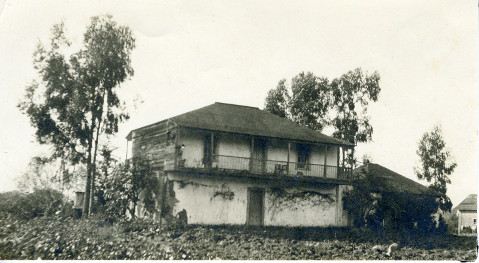An Infamous, Unsolved Mystery
The Trabucco Murder in 1881 Involved Robbery, Torture, and Accusations

The infamous Trabucco murder is a tale of robbery, torture, and death, and it shocked the citizens of Santa Barbara in the early 1880s. And the why and wherefore of the crime remain mysteries to this day.

The Masini adobe on Sheffield Drive in Montecito is a Santa Barbara County Landmark. The exact construction date of the home remains in question; it was probably built sometime in the first half of the 1820s. The original owner is also unknown. The adobe got its name from Pedro Masini, who purchased the adobe and surrounding acreage in 1868. Masini was involved in the asphaltum industry and also developed a vineyard on his property.
The family sold the adobe in 1878, and by 1881 Giovanni B. Trabucco called the adobe home. In his mid-fifties, he was described in a local newspaper as “industrious” and “warm-hearted,” yet also “isolated.” He lived alone. Rumors had flown for some time that he was hoarding a significant amount of cash in his home. Was it this that sealed his ultimate fate?
On the morning of December 23, 1881, Giovanni Trabucco was found lying on his kitchen floor “covered with ghastly wounds.” He had been slashed in the chest, stabbed in the heart, and “his throat was cut from ear to ear.” He had been beaten about the head and shot. His dining table was set with four glasses and an empty bottle of wine. Had he been entertaining his murderers?
Authorities came to the conclusion that Trabucco was most probably seeing his guests to the door when set upon. Bound hand and foot, the perpetrators used whatever measures necessary to extract from Trabucco the whereabouts of his cache of wealth. Investigators found a sack with $650 in it. There were also a number of empty sacks scattered around. Had the murderers successfully absconded with some blood money or had they left in frustration?
Santa Barbarans were outraged. Citizens subscribed $1,000 for information leading to any arrests, with the governor authorizing an additional $500. One reporter wrote that the crime “was too heartless, too brutal to go unknown and unpunished.”
In June 1882, five brothers named Romero were arrested and charged. The big break had come when one Victor Olivas, a resident of state prison at the time, said he had been in on the plot with the Romeros to rob Trabucco. But after he was sent to prison for another crime, the remaining conspirators decided to carry on. According to Olivas, Trabucco was only to be killed if he recognized someone.
It soon was apparent that Olivas’s story just would not hold water. Would Trabucco have dined with perfect strangers? Also, the character of the Romeros was impeccable; dozens of people came forward to vouch for them. Finally it became obvious that Olivas was simply hoping to get on the good side of the law with his fabrication and may have been seeking revenge for some unnamed slight or injury. The Romeros were released.
And there it stands to this day — no convictions, questions unanswered, with an evidence trail over 130 years old. It is Santa Barbara’s “Unsolved Mystery.”



